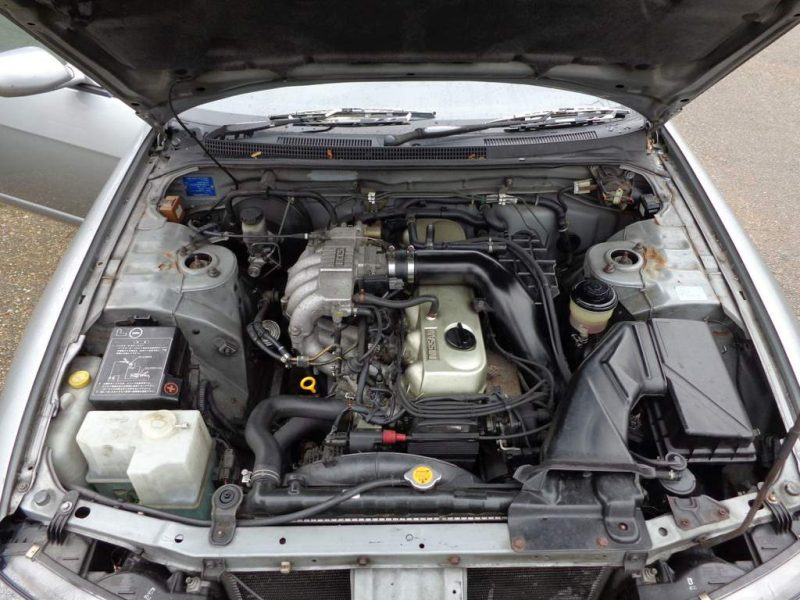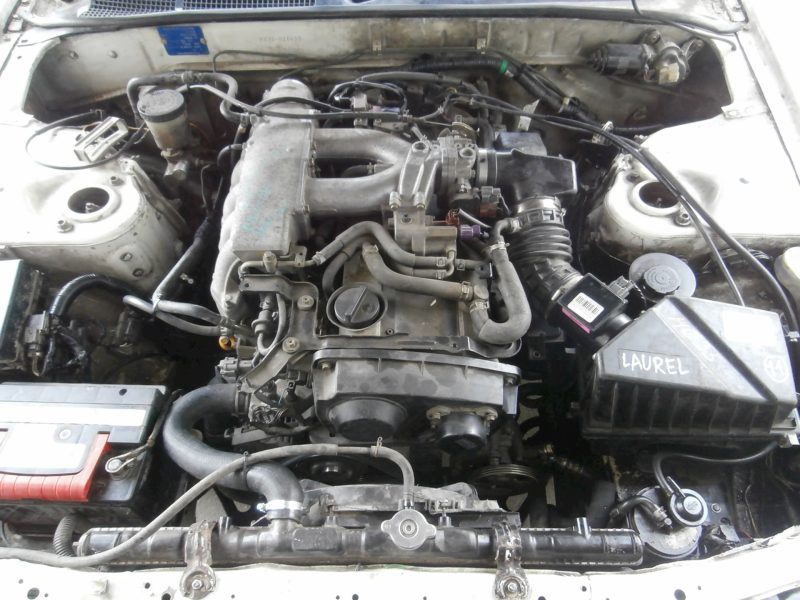2.0-liter Nissan RB20DE engine was produced by the company from 1985 to 2002 in Japan and was installed in many popular mid-size car models of that time. Around 2000, a modernized version of this unit with the prefix NEO appeared.
Characteristics of Nissan RB20DE 2.0 engine
| Characteristics | RB20DE (standard) | RB20DE NEO |
|---|---|---|
| Precise displacement | 1998 cm³ | 1998 cm³ |
| Power System | Distributed injection | Distributed injection |
| Power | 150-165 hp | 155 hp |
| Torque | 180-185 N-m | 180 N-m |
| Cylinder block | Cast iron, in-line R6 | Cast iron, in-line R6 |
| Cylinder head | Aluminum, 24 valves | Aluminum, 24 valves |
| Cylinder diameter | 78 mm | 78 mm |
| Piston stroke | 69.7 mm | 69.7 mm |
| Compression ratio | 9.5-10 | 10 |
| Features | No | ECCS |
| Hydrocompensators | Yes | No |
| Transmission timing | Belt drive | Belt drive |
| Fasoregulator | No | No |
| Turbocharger | No | No |
| Recommended Oil | 4.3 liters 5W-30 | 4.3 liters 5W-30 |
| Environmental class | EURO 2/3 | EURO 3/4 |
| Example service life | 400,000 km | 350,000 km |
| Engine weight | 230 kg | 230 kg |
Application of RB20DE engine
The RB20DE engine has been installed in the following Nissan models:
| Model | Body | Years of production |
|---|---|---|
| Nissan Cefiro | A31 | 1988-1994 |
| Nissan Laurel | C33 | 1989-1993 |
| C34 | 1993-1997 | |
| C35 | 1997-2002 | |
| Nissan Skyline | R31 | 1985-1990 |
| R32 | 1989-1994 | |
| R33 | 1993-1998 | |
| R34 | 1999-2002 | |
| Nissan Stagea | WC34 | 1996-2001 |
Troubleshooting and repair of RB20DE/RB20DET engine

The legendary Nissan RB series appeared in 1984 and its smallest representative, called RB20, was produced as a replacement for the old L20. The RB20E engine, which was the name of the first version, is an inline six in a cast iron cylinder block, with a short-stroke crankshaft. From above the engine is covered with aluminum single-shaft cylinder head with 2 valves per cylinder. Power ranges from 115 to 130 hp, depending on generation. In general, this version is poorly distributed and does not represent anything interesting, besides it is very weak. The next model, released in 1985, was called RB20ET and was the same RB20E, but with a turbocharger blowing 0.5 bar without intercooler. Power of such motor was 170 hp, in some variations – 145 hp.
In the same 1985, the most famous two-liter RB – RB20DE appeared. Its main difference from the RB20E is a twin-shaft 24-valve cylinder head with individual ignition coils, as well as a new crankshaft, connecting rods, pistons, intake system, control unit. The camshafts were 232/240, lift 7.3/7.8 mm. These motors developed from 150 hp to 165 hp and were installed on the following Nissan cars: Skyline R31/R32, Cefiro A31, Laurel C33/C34.
The RB20DE engine bends valves when the timing belt breaks.
Toward the end of production, since 2000, RB20DE underwent some modifications and gave the name RB20DE NEO. These motors are characterized by improved environmental performance, as well as crankshaft, intake system, modernized cylinder head without hydrocompensators, control unit. The power of this engine is 155 hp.
There are RB20DE NEO on Nissan Skyline R34, Stagea C34, Laurel C35.
In the same year, a turbo version of the above motor was released, called RB20DET. These powerplants were equipped with a 16V turbocharger operating at 0.5 bar. Under the supercharger was reduced compression ratio to 8.5, replaced pistons, connecting rods, crankshaft, cylinder-head gasket, control unit, used injectors 270 cc/min. The first models (RB20DET Red top for Skyline R31) used NICS intake, installed camshafts with phase 248/240, lift 7.8/7.8 mm. With them the engine developed 180-190 hp, depending on the model. Later, since 1988, ECCS system and camshafts 240/240, 7.8/7.8 mm lift were used. Such motor is usually called RB20DET Silver top, its power increased to 215 hp at 6400 rpm.
The RB20DET engine was discontinued in 1993, as the atmospheric RB25DE, with approximately similar power, was introduced.
RB20DE/DET engines do not require valve adjustment, except RB20DE NEO, which is not equipped with hydrocompensators. The timing drive on RB20 is belt-driven, timing belt replacement is necessary every 80-100 thousand kilometers.
In addition to RB20, this series included RB24S, RB25DE/DET, RB26DETT and RB30S/E/ET.
After the end of production of RB20DE/E, this motor was replaced by VQ23DE.
Problems and disadvantages of Nissan RB20DET/DE engines

RB20 engines are very reliable, as well as the whole RB series, with regular maintenance, use of quality engine oil, quality gasoline, without boost, these motors will pass not one hundred thousand kilometers. These power units, as well as other RBs, are inherent in the problem with trojan, due to the failure of ignition coils. They should be replaced every 100 thousand kilometers. Also, the motors are quite voracious and like to spend fuel in quantities more than usual.
Nissan RB20DET engine tuning
RB20DET Boost Up
It should be noted that tuning RB20DE and RB20E, by installing camshafts and other parts, is a waste of time and money, RB20DET with boost up will always be ahead for less money. Also, don’t try to turbocharge an RB20DE, it’s easier to buy a contract RB20DET right away.
That leaves you with the most perfect RB20DET, and it’s worth a little boost. The problem is that the stock turbocharger is not the best option for tuning, the maximum safe supercharger is 0.8 bar (occasionally possible, but not desirable, 0.9 bar), which will give about 260-270 hp (motor). For this you need to buy injectors from RB26DETT 444 cc/min, as well as intercooler from Skyline GTR, westgate, downpipe, straight exhaust on 76mm pipe, maf RB25 or 300ZX, boost controller, pump Walbro 255 or from GTR, as well as candles. Tune it up and you’ll run the quarter mile in an average 13 secs.
By replacing the turbo with a 45V4 from an RB25DET (Skyline R34), buying an Apexi power FC and a cold intake, you can increase power to a motorized 300-320hp. As an option you can use HKS GT2530 turbine, at pressure of 1.4-1.5 bar it will show about 350 hp. These are two of the most optimal, fast and reliable configurations.
You can also use the HKS GT2535 or HKS GT2540, with 256/256 camshafts, which will take off 350-400 hp.
Installing a TD06 20G turbo, 264/264 camshafts, Splitfire coils, Bosch 044 pump, Nissan GTR R35 570 cc injectors, metal cylinder-head gasket, ARP studs, you can blow 1.2 bar and get 400 hp. Increasing the pressure to 1.7-1.8 bar, you will get about 450-470 hp and pass the quater for low 12 sec. In general, it is better not to inflate more than 400 hp on stock pistons, it is safer and more reliable.
There is no sense to move further, for 450-500 hp and more, there are too many modifications, it is easier to buy RB25DET or RB26DETT engine.
As an option you can spit on everything and buy a cheap Chinese turbo kit for RB20DET, inflate the same 350 hp, but, most likely, it will soon come in disrepair.
RB20DET Stroker
For this engine, there are options to increase displacement from 2.05 liters to 2.33 liters. Boring the cylinder block to 81 mm, under the Toyota 4A-GZE piston, you will get 2.15 liters. Boring to 82 mm, under Tomei pistons, you get 2.2 liters. Leaving the cylinders standard, but installing a crankshaft and connecting rods from RB25DET, the volume will increase to 2.05 liters. Adding 4A-GZE pistons, you get 2.2 liters. Buying a crankshaft and connecting rods from RB26DETT, while leaving the cylinders stock, the motor will be 2.1 liters. Adding 4A-GZE pistons will give you 2.3 liters. If you use Tomei 82mm pistons instead of Toyota pistons, you get 2.33 liters.
ENGINE RATING: 5-
